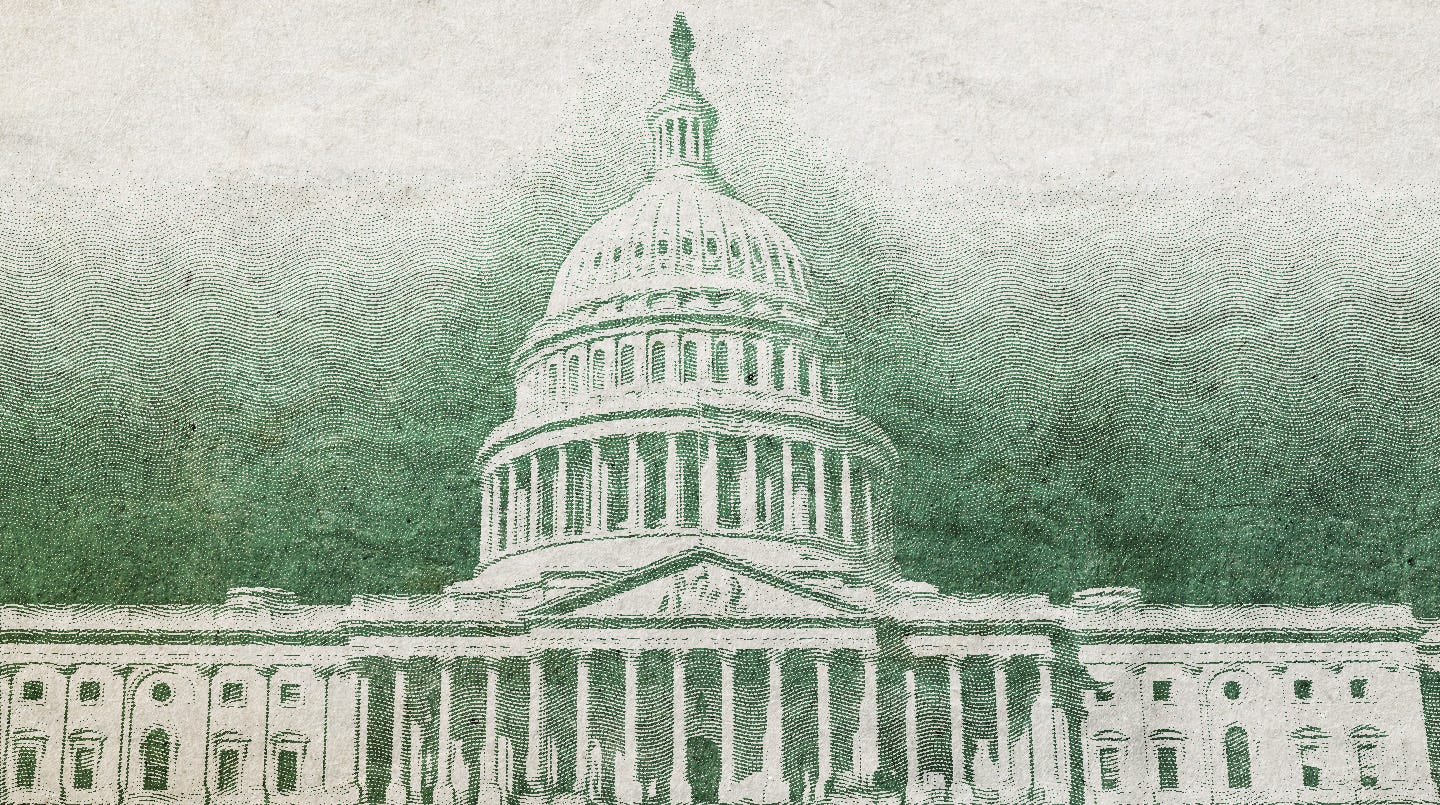Founders Would Be Horrified by Congress's Surrender of its Power of the Purse to POTUS
The shutdown is testimony to how a subservient legislature makes governance dysfunctional
The power of the purse, the idea that matters of taxation and spending belong in the hands of a representative legislature, is the fundamental bedrock of the Anglo-American constitutional tradition. It was the basis of Parliament’s fight against the “personal rule” of Charles I. It was the rallying cry of the American Revolution—“no taxation without representation.” And it is firmly codified in the supreme law of the land, the Constitution. Article 1, Section 9, Clause 1 states plainly that “No Money shall be drawn from the Treasury, but in Consequence of Appropriations made by Law.”
Over the years, Congress and successive presidents have wrangled over this control, with chief executives trying to assert more say over the federal government’s checkbook. But as with many other parts of the Constitution, the second Trump administration is taking matters to new levels. The shutdown might be over (for now), but we see in this latest round how a dysfunctional executive-legislative balance of spending powers can make governing harder and more contentious. It’s difficult to negotiate a bipartisan deal through Congress if one party, in control of the White House, can then disregard whatever it doesn’t like.
The administration has ignored laws Congress has enacted over the years that specify how the executive branch should approach allocating the funds that Congress appropriates. One, the Antideficiency Act, dates to the 19th century and ensures that agencies do not spend more than has been allocated to them. A second, the Impoundment Control Act (ICA), was enacted in 1974 and specifies exactly what the executive branch must do—including getting the consent of Congress—if it wishes to cancel funding the legislature has already allocated. So it’s not the case that Congress, historically, has done nothing to try to guard the appropriations power against encroachment—but we are seeing many of these measures are insufficient for a period of strong partisanship.
New Heights of Flouting
The specific incursions by the executive branch into Congress’s spending power have been legion—indeed, too legion to detail each here. But they have included attacks from both directions: The executive branch has withheld funds that Congress has told it to spend (underspending) and also has used resources for a purpose different from what Congress had allocated them for (misspending or overspending).
In the underspending context, the Government Accountability Office has responsibility for investigating allegations that the president has elected not to spend funds in violation of the ICA. While prior presidents have seen actions investigated by the agency, the number of GAO opinions identifying violations—seven as of this writing—is a marked increase. And that is likely a significant undercount, since it only includes actions on which GAO has completed an investigation. But even within these seven, there are instances of grant cancellations (at NIH and FEMA), delays in the ability to access grant funds (from the Department of Education), delays in expenditures (at the Department of Transportation), and an attempt to cease most of the operations at a federal agency (the Institute of Museum and Library Sciences). Taken together, these actions represent an illustrative cross section of the types of underspending that the administration has undertaken to weaken Congress’s constitutional prerogative.
A key component of the administration’s strategy to underspend Congress’s intent has been to manipulate the timing of certain actions to do an end-run around congressional spending decisions. Many funds appropriated annually by Congress are available for just a single fiscal year, expiring at its conclusion on Sept. 30, at which point the money, absent successful litigation, disappears if not spent. The administration has sought to leverage this fact by using so-called “pocket rescissions.” These let a president kill funding authorized by Congress without the legislature having to formally weigh in and approve the cancellation.
There is a legal, if potentially destabilizing, way to do recissions and the administration used that method earlier this year. The president sent rescission requests to Congress to approve the cancellation of funds, and Congress agreed; the practice still threatens congressional power because it allows simple majorities to undo bipartisan appropriations which had previously cleared the 60-vote filibuster threshold in the Senate.
But for a set of foreign aid funds, the administration gamed the process in a way that the GAO has determined is illegal. This “pocket rescission” works by first hitting the pause button on spending by submitting a rescission request to Congress, but doing so with less than 45 days before the funding’s expiration date. This means that if Congress does not affirmatively act and require the spending within that time period, the funds can expire without being spent nor Congress agreeing not to spend them. The Supreme Court allowed the expiration date for the funds to pass without weighing in on the merits of whether this practice is legal, and litigation continues. But even if the high court ultimately rules against the Trump administration, the circuitous path to satisfying congressional intent illustrates the limits of using the courts as a timely backstop to congressional power.
In addition to proposing the explicit cancellation of specific funds, evidence also suggests that the administration purposefully slow-walked the process of getting other money out the door. One important step in the process of spending federal resources is known as “obligation,” or the point at which an agency incurs a legally binding commitment to spend money, like a contract to purchase supplies. Data on obligations during the early months of the Trump administration indicates that agencies committed substantially smaller amounts than would be expected based on historical trends, including for a set of programs the administration would like to eliminate entirely.
Administration officials have also sought to use a key component of the budget execution process, known as apportionments, to manipulate the flow of the funds that Congress has approved. To ensure that agencies do not burn through their annual appropriations too quickly, and that funds allocated over multiple years are used effectively, the Office of Management and Budget (OMB) is responsible for signing off on agencies’ ability to access the resources that Congress has appropriated. Over the course of this year, administration officials have, with a frequency not seen in prior administrations, required agencies to submit “spending plans” that explain how they intend to use the funds in “align[ment] with Administration priorities” in order to be able to spend their appropriated funds. In other words, the administration is attempting to place additional requirements on spending beyond those already outlined by Congress. (The administration also illegally hid this practice and other aspects of the apportionment process from the public by removing, in March, a mandated public web site that discloses apportionment information. It was restored in July only after a successful court case.)
We have also seen the administration mount a visible attack on the second pillar of the appropriations power—not just refusing to spend money Congress has directed, but spending funds in ways Congress has not authorized. This is an even more fundamental, and potentially dangerous, violation of the power of the purse. The most visible has been the recent decision, during the lapse in appropriations in Oct. and Nov., to use money previously appropriated for research and development activity at the Department of Defense to issue paychecks to military personnel.
(In light of the English and colonial-era history, the Framers were particularly keen on appropriations as a check on the military: a special rule in the Constitution prohibits appropriations “[t]o raise and support Armies” from lasting longer than two years.)
There are a range of possible reforms Congress could and should adopt to limit this illegal behavior. These include expressly prohibiting pocket rescissions, reforming the apportionment process (including, potentially, taking the apportionment authority from OMB and giving it to Congress), and making it easier for affected parties to sue in the event of a grant termination. And undergirding it all, Congress needs to be willing to proactively defend its prerogatives even when the same party controls the White House and both chambers.
Coequal No More
Fundamentally, restraining the executive is a political problem, not a procedural one. The current statutory limits on underspending were enacted in response to specific activities by President Nixon in an era when members of Congress more jealously guarded their collective power, and how it might be wielded against a president of either party. But even in a period of greater institutional patriotism, many Republicans opposed placing new guardrails around impoundment; even then, members who favored lower spending saw the tool as a potentially useful one. For some fiscal conservatives, the prospect of impoundment can seem tempting, akin to a line-item veto, even as it inflates presidential control at the expense of Congress and undermines the constitutional separation of powers.
In the current Congress, collective action as motivated by anything other than clear partisan motivations is hard to envision. Indeed, when Republican members of Congress have found that the executive branch is targeting programs of particular importance to their states and districts, their response has generally not been to engage in coalition-building to use Congress’s institutional power to respond. Rather, it has been to use their individual influence to persuade the executive branch not to take action that would hurt their constituents. This completely inverts the constitutional scheme, reducing senators and representatives to mere supplicants of the administration, begging for favors, instead of acting like members of the body with the relevant power.
In March, for example, Rep. Tom Cole (R-Okla.) released a statement claiming credit for “working closely with DOGE and the Administration” to keep three federal facilities in Oklahoma from closing. In July, Senator Mike Rounds (R-S.D.) similarly touted the fact that he “worked with the Trump administration to find unused climate change money that will be reallocated to continue grants to tribal radio stations”—support that was under threat as a result of the administration’s ultimately successful request to rescind funds for the Corporation for Public Broadcasting. (Importantly, it’s not clear whether the deal Rounds secured will actually address the underlying problem of funding cuts for tribal radio over the long term.)
As long as members who find the administration’s actions objectionable find it possible to go directly to the White House to resolve the concerns that are targeting their specific constituents—and finding at least enough success that they can claim some credit for “fixing” the issue—there’s little incentive to pursue the harder, collective action that would reassert Congress’s institutional power. In order to block this easy way out that allows members of Congress to defect from defending Congress’s authority, it is essential to block the executive branch from having so much discretion at all. At the end of the day, congressional appropriations aren’t just a budget spreadsheet: they are laws, and the rule of law must be upheld.
© The UnPopulist, 2025
Follow us on Bluesky, Threads, YouTube, TikTok, Facebook, Instagram, and X.
We welcome your reactions and replies. Please adhere to our comments policy.







Don’t forget “and nauseated”.